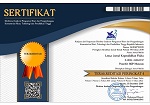PENGARUH PENERAPAN MODEL PEMBELAJARAN DIRECT INSTRUCTION BERBANTUAN MEDIA ANIMASI TERHADAP HASIL BELAJAR FISIKA SISWA KELAS VIII SMP NEGERI 1 BATU LAYAR
DOI:
https://doi.org/10.33394/j-lkf.v2i1.306Keywords:
direct instruction model, animation media, physics academic acheivement.Abstract
This study is a quasi experimental study that aims to determine the effect of using direct instruction model with animation media to the academic achievement of physiscs in student class VIII SMP Negeri 1 Batu Layar. The population in this study were all students of class VIII SMP Negeri 1 Batu Layar that were 87 students. Whereas the students of class VIIIA which are 22 students as the experimental group and 22 students of class VIIIC as a control group. Sampling methode was random cluster sampling. The Research design using pre-test - post-test control group design. Based on Pre-test result, the average mark of class VIIIA and class VIIIC were 24.70 and 28.95, respectively. Post-test result gave the information that the average mark of class VIIIA and class VIIIC were 79.29 and 71.62 respectively. Research hypotesis was analyzed using polled varians t-test. It can be concluded that there was a different in physics academic achievement between experimental group and control group, where the experimental group using direct instruction model with animation media as the treatment and the control group using direct instruction only. The academic achievement of experimental group were better than control group, it can be a reason to say that the treatment by using direct instruction model with animation media gave the positive effect to the academic achievement of physiscs in student class VIII SMP Negeri 1 Batu Layar.
References
Arikunto, Suharsimi. 2009. Dasar-dasar Evaluasi Pendidikan. Jakarta: Bumi Aksara.
Arsyad, Azhar. 2011.Media Pembelajaran. Jakarta: Rajawali Pers.
Djamarah, Saiful Bahri, dan Zain, Aswan. 2006. Strategi Belajar Mengajar. Jakarta: Rineka Cipta.
Riyanto, Yatim. 2010. Paradigma Baru Pembelajaran Sebagai Refrensi Bagi Pendidik dalam Implementasi Pembelajaran Yang Efektif dan Berkualitas. Jakarta: Kencana.
Sakti dkk. 2012. Pengaruh Model Pembalajaran Langsung (Direct Instruction) Melalui Media Animasi Berbasis Macromedia Flash Terhadap Minat Belajar dan Pemahaman Konsep Fisika Siswa di SMA Plus Negeri 7 Kota Bengkulu. Jurnal Exacta Vol. X, No. 1. Universitas Bengkulu.
Side, Harsidi. 2009. Penggunaan Media Animasi dalam Model Pembelajaran Langsung untuk Meningkatkan Hasil Belajar Biologi Siswa Kelas VIII3 SMP Negeri 13 Makassar. Skripsi: Fakultas Matematika dan Ilmu Pengetahuan Alam Universitas Negeri Makassar (Tidak Diterbitkan).
Sugiyono. 2012. Metode Penelitian Pendidikan Pendekatan Kuantitatif, Kualititatif dan R&D. Bandung: Alfabeta.
Downloads
Published
How to Cite
Issue
Section
License
Authors who publish with Lensa: Jurnal Kependidikan Fisika agree to the following terms:
- For all articles published in Lensa: Jurnal Kependidikan Fisika, copyright is retained by the authors. Authors give permission to the publisher to announce the work with conditions. When the manuscript is accepted for publication, the authors agree to automatic transfer of the publishing right to the publisher.
- Authors retain copyright and grant the journal right of first publication with the work simultaneously licensed under a Creative Commons Attribution-ShareAlike 4.0 International License that allows others to share the work with an acknowledgment of the work's authorship and initial publication in this journal.
- Authors are able to enter into separate, additional contractual arrangements for the non-exclusive distribution of the journal's published version of the work (e.g., post it to an institutional repository or publish it in a book), with an acknowledgment of its initial publication in this journal.
- Authors are permitted and encouraged to post their work online (e.g., in institutional repositories or on their website) prior to and during the submission process, as it can lead to productive exchanges, as well as earlier and greater citation of published work (See The Effect of Open Access).

This work is licensed under a Creative Commons Attribution-ShareAlike 4.0 International License.



